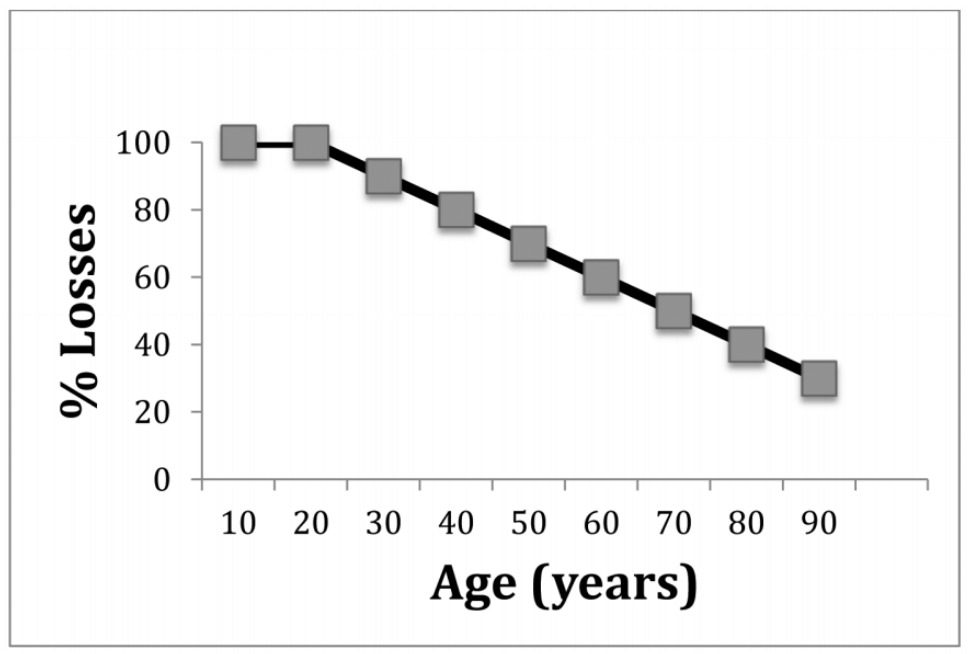Exercise-Ageing
Age-Related Losses in Skeletal Muscle Mass and Contraction Strengths06/17

Body Balance
The reported age-related 1.0% per year loss in skeletal-muscle mass as shown in Figure 1 results in a reduction of the number of muscle fibers within the respective muscles and produces a corresponding loss in sensory nerves and motor end-plates regulating body balance. These losses reduce your body-balance ability and thereby increase your susceptibility to falls and fractures.
Bone Density
The reported age-related 1.0% per year loss in skeletal-muscle contraction strength reduces the pulling force of skeletal muscles at their respective skeletal-muscle- tendon connections. Any such curtailment of the pulling force of a muscle at the muscle-bone- tendon junction reduces the stress on the bone needed to nurture normal bone growth. This curtailment causes the bone to demineralize. This demineralization results in a reduction in bone density, a condition referred to as osteoporosis.
Age related osteoporosis, especially in women, occurs about age 50. Osteoporosis causes the following complications: an increase in postural deformities of the spinal column, an increase in vulnerability to fractures, and an increase in the time needed for prevailing fractures to heal.
Accumulative Effects of Losses in Skeletal Muscle Mass, Contraction Strength, Body Balance, and Bone Density
The accumulative effects of age-related losses in skeletal muscle mass and contraction strength, body balance, and bone density have a specific effect on your ability to perform life's daily activities.
- Your walking-gait becomes uncoordinated, you drag your feet, and you become susceptible to tripping
- You tend to be unsteady and insecure climbing and descending stairs
- Rising from a chair, tub, bed, or a lavatory seat becomes demanding
- You have difficulty dressing, bathing and body grooming
- Your hands tremble when you eat or drink
- It becomes difficult to pursue recreational physical activities and formal exercise routines
Moreover, the accumulative effects of the age-related losses in muscle mass, contraction strength, body balance, and bone density leave you susceptible to one or more of the following statistical predictions:
- 80% of Americans suffer from lower-back pain
- Over two million older adults suffer from complications resulting from serious falls each year
- 20% of Americans die from hip-fracture complications each year
And, as your age-related losses in muscle mass and strength, body balance, and bone density increase even further, you may have to use a walker-assistance unit to accommodate your walking needs, or an electric-shopping cart when you go to the grocery or department store. You are now in a state of dependency and have reached the age-projected stage of discontented living.
What is the cause of the age-related losses in muscle contraction strength and the resulting compromises you may experience as you attempt to perform life's daily activities? The answer to this compelling question is muscle atrophy (wasting away of muscle tissue).
Muscle Atrophy
Muscle atrophy involves the wasting away of muscle tissue, the loss of the number of muscle fibers in an individual muscle, and the reduction in contraction strength in that muscle. Muscle atrophy is caused by the disuse, over time, in any one of the body's 626 respective muscle groups. This atrophy-disuse reaction may be attributed to sedentary lifestyles and failure to place a progressive-exercise- resistance stress on the body's skeletal musculature. To help prevent age-related muscle atrophy, sedentary- inclined seniors need to adhere to an effective Resistance Training Program.